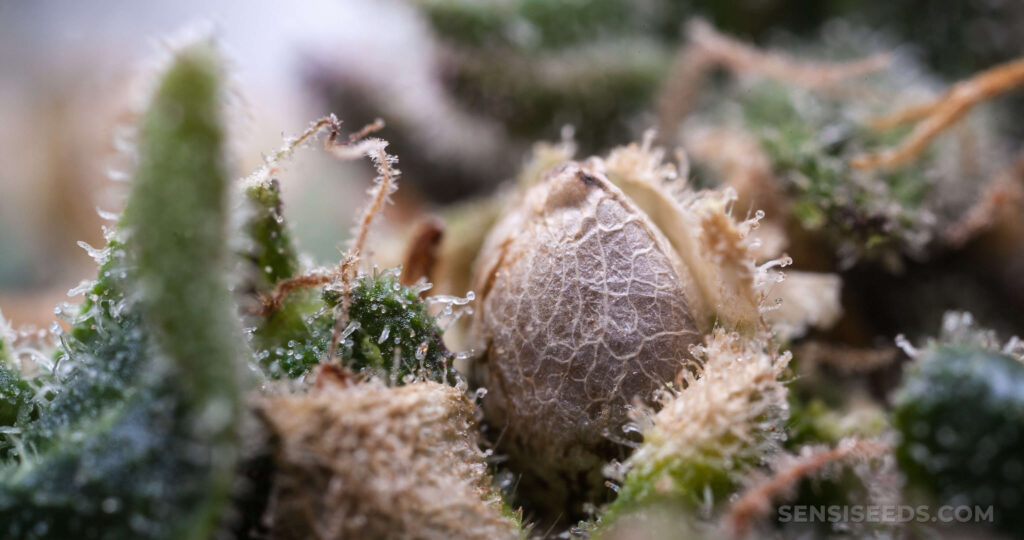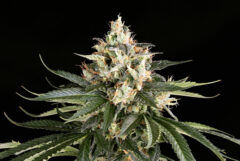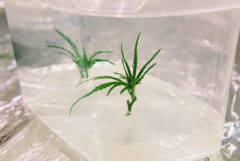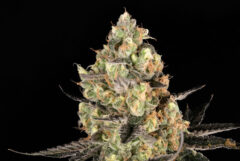Found a seed at the bottom of your weed bag or jar and wondering whether to grow it out or can it? Let’s take a look at the marvel of bag seeds – what they are, where they come from, and the challenges and rewards of growing them.
“Bag seeds” is the term cannabis growers and smokers use to refer to random weed seeds found in a bud or at the bottom of a weed bag. They usually come from plants that were accidentally or unknowingly pollinated.
Unlike the seeds you’d buy from Sensi Seeds or another seedbank, bag seeds have dubious origins. That doesn’t necessarily mean that they’re ‘bad’ (see “Are bag seeds worth growing” below). However, it does mean that growing them entails a few (or a lot) of surprises.
Keep reading for a detailed look at bag seeds and how they differ from the seeds you’d buy from a seedbank or breeder. Plus, we’ll also share some of our personal experiences with growing bag seeds and the different results they can produce, so you can decide for yourself whether or not you’ll grow out those mystery beans you have stashed away.
How cannabis breeding works
To better understand how bag seeds differ from the seeds you can buy at Sensi Seeds or from other reputable seedbanks, it’s important to have at least a basic understanding of the work that goes into breeding unique cannabis strains and making them available in seed form.
On the one hand, creating a weed seed is super simple – take some pollen from a male plant and spray it on the flowers of a female and, in a matter of weeks, you’ll have not one but potentially hundreds of seeds on your hands.
Out in nature, cannabis plants cross pollinate constantly, creating seeds with all kinds of genetic information. The procedure for making seeds like those sold at Sensi Seeds, however, is a little more complex and involves special breeding techniques. Our expert geneticists, despite all their experience, can take years to develop strains like those in our catalogue.
First, they’ll grow out, clone, and archive a large number of plants. As they grow, our geneticists will separate the males from the females and look for plants with particularly favourable traits. These can include:
- A stature particularly favourable to a specific style of growing
- A fast flowering time
- Peculiar aromas and flavours
- High resin production
- A high concentration of specific cannabinoids
- A particular bud structure
- Resilience to pests and pathogens
The process of looking for plants with desirable traits is called “phenohunting” and can involve sifting through hundreds of plant “phenotypes”. A phenotype refers to a plant’s observable traits, which are the specific expression of the genetic information provided by a plant’s “genotype” (i.e. it’s DNA). Phenos can vary greatly, even when they come from the same parent plants – just like you might look very different to your siblings.
Phenohunts can involve tends to hundreds of plants and take months to years to complete – after all, growers need to grow out the plants, observe and track them, clone them to keep an archive, and harvest them to see what kind of flower they produce.
Once they’ve spotted plants with traits that they like, our breeders will look to stabilise these traits using techniques like in-breeding and backcrossing. In doing so, our breeders start to craft genetic lines with reduced genetic information, which helps to ensure the prevalence of desirable traits in the offspring of that line.
Finally, after establishing a breeding line (which can take years), our breeders may cross 2 specific lines to create plants with improved vigour and a combination of sought-after growth traits. Again, the resulting strain may be stabilised using techniques like inbreeding or backcrossing. All in all, the work that goes into creating beloved Sensi Seeds strains like Skunk #1, Black Domina, or Jack Herer takes plenty of time and effort.
The genetic lottery of bag seeds

Whereas the seeds created at Sensi Seeds and other quality seedbanks are a refined, carefully produced product, bag seeds are the complete opposite. That’s because they’re created by accident.
Today, growers typically grow sinsemilla i.e. seedless weed. This technique involves separating male and female plants. This keeps the females unpollinated for prolonged periods, forcing them to create larger, more resinous, and subsequently more potent flowers.
Hence, most bag seeds are the result of unwanted pollination, which usually occurs when growers don’t separate male plants from the females in time, or by the presence of hermaphrodites (“hermies”) in a grower’s garden. Outdoors, females can also easily be pollinated by male plants growing in other nearby areas (say a garden across the street or a few blocks away).
Since they’re created by accident, bag seeds don’t undergo all the breeding processes we described earlier (which essentially help reduce a plant’s genetic information so it only develops specific sought-after traits). Unlike properly bred seeds, therefore, bag seeds can contain a plethora of genetic information and produce plants with very varied traits.
Are bag seeds worth growing?

This is a common question, the answer to which really depends on what your goals are when growing cannabis.
Are you a grower/smoker with particular preferences for specific genetics, aromas, flavours, or effects? Or do you only grow strains with specific growth traits to suit the limitations of your grow space? Then bag seeds aren’t for you, because growing them is a complete lottery.
If, on the other hand, you love experimenting with unique genetics and have the means to care for plants of differing statures and with varying traits, then bag seeds can prove a fun (and sometimes fruitful) experiment.
Pros of growing bag seeds
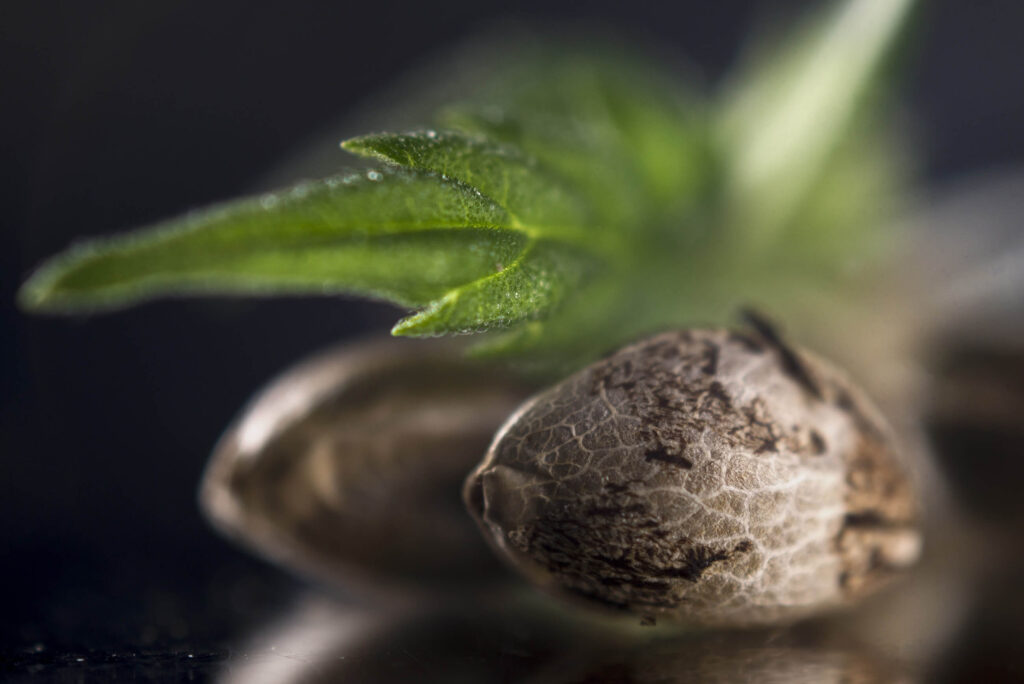
Some of the pros of growing bag seeds, for example, include:
1. They’re free
You won’t have to pay top dollar for bag seeds. Instead, you just need to be lucky enough to find them in a bud or at the bottom of a bag or jar.
2. They’re easy to find
Forget about shipping limitations or wait times. Buy enough weed and, sooner or later, you’ll come across some bag seeds. Alternatively, ask your smoking buddies – they’re sure to have seeds laying around from some random stash they bought ages ago.
3. They’re fun
Many growers love the element of surprise that comes with growing bag seeds.
4. They can produce excellent results
Sometimes, bag seeds can produce incredible plants. In fact, many iconic strains came from bag seeds, including Chemdawg, Sour D, Bubba Kush, and many more.
Cons of growing bag seeds
At the same time, growing bag seeds also comes with some cons, including:
1. Low germination rates
There’s no knowing how old bag seeds are or how they were stored, meaning they might not always germinate.
2. High chances of growing males
Grow bag seeds and you’ll need to wait at least 4-6 weeks to get an idea of the sex of your plants, meaning you might spend money on soil and pots for plants that you could end up culling.
3. High prevalence of hermies
A lot of bag seeds come from the presence of a hermaphrodite plant in a grower’s room/tent/garden. Hence, they may be genetically prone to developing hermaphroditic flowers.
4. Random aromas, flavours, and effects
When growing bag seeds, there’s no knowing what you’re weed is going to smell, taste, or smoke like.
Today, we truly live in the “golden age” of cannabis. Thanks to the legalisation of weed in various parts of the world, there’s never been a larger variety of strains to choose from for your home garden. In that sense, there’s little need for home growers to grow bag seeds, unless they live in an area where it’s extremely hard or dangerous to get seeds delivered.
Nevertheless, some growers like the novelty of growing a plant that they wouldn’t find anywhere else. And for those people, bag seeds are an entry point into a whole other world of opportunity.
What can you expect when growing bag seeds?
Personally, I’ve grown both purchased seeds from reputable seedbanks as well as bag seeds, and I’ve had great results with both. One of my first grows, for example, was with bag seeds I scavenged from some Paraguayan brick weed (I live in South America, where a lot of clandestine cannabis comes from large, open-air guerrilla grows in Paraguay). Though the plants looked and smelled very different, the flowers they produced were a pleasure to smoke.
One summer, I also grew Lemon Blue Cheese plants by Silver River Seeds – a seedbank from Uruguay ran by a renowned grower and breeder. One of the plants hermied and produced a ton of seeds, some of which I sowed in following harvests. While some of the offspring produced small yields of delicious bud, most turned out to be hermies which I needed to cull in order to keep my other plants from getting pollinated.
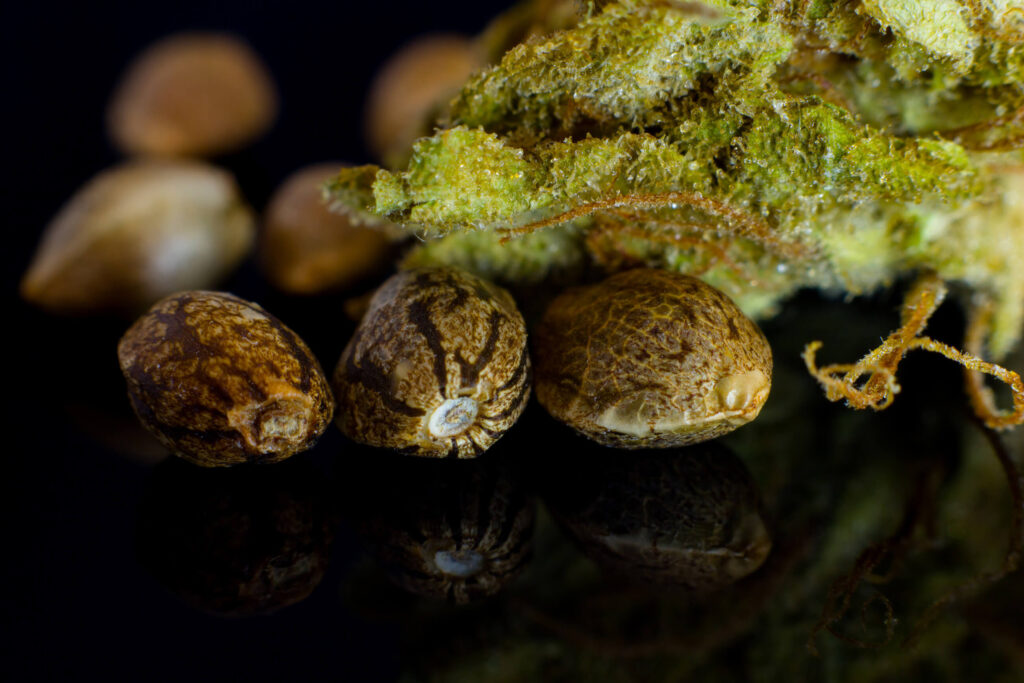
Meanwhile, I’ve also witnessed friends and acquaintances grow out bag seeds and stray upon absolute FIRE plants. One friend, in particular, also grew out a bunch of Paraguayan bag seeds, one of which he ended up cloning and keeping in his garden for several seasons, because he was in love with the unique aromas and flavours of that particular plant!
The bottom line? Uncertainty is the only certainty when it comes to growing bag seeds. Don’t grow them if you need a hassle-free grow and a predictable harvest. Instead, pop bag seeds when you don’t want to spend money on properly bred seeds, but do so knowing that you might be in for a rollercoaster ride that might or might not be worth it.
Do bag seeds contain good genetics?
Bag seeds can contain all kinds of genetics which are impossible to properly identify. If you found a seed in a bag of Jack Herer, for example, it would be a safe bet to say that the seed is a descendant of a Jack Herer mother. However, that doesn’t mean that, if you were to pop that bag seed, it would produce a Jack Herer plant.

As we mentioned earlier, the strains from seedbanks you know and love take years to create and are the product of special breeding techniques that help ensure that a plant produces very specific traits.
When a plant like Jack Herer is pollinated by another plant, the resulting seed no longer just contains Jack Herer genetics, but also the genetics of whatever the pollinating plant was. This results in seeds with a larger genetic blueprint, which in turn opens up the variables of what kind of plant those seeds can produce.
How to store bag seeds
Found a couple of seeds in your weed and want to hold on to them for a future growing project? Here’s how to store them properly so they keep for longer:
- Pick out and discard any underdeveloped (i.e. ‘green’) or broken seeds.
- Make sure your remaining seeds are dry. You can do this by keeping them on a plate between a few layers of paper towel for 1-2 days.
- Place your dry seeds in a sealed container with a desiccant (such as silica gel) and store them in the fridge.
Check out our article on how to store cannabis seeds for a more detailed look at how to ensure your weed seeds keep for longer.
Do you grow bag seeds, or do you prefer growing proper seed stock from reputable seedbanks? Share your thoughts on and experiences with bag seeds below – we’d love to hear from you!
- Disclaimer:Laws and regulations regarding cannabis cultivation differ from country to country. Sensi Seeds therefore strongly advises you to check your local laws and regulations. Do not act in conflict with the law.






